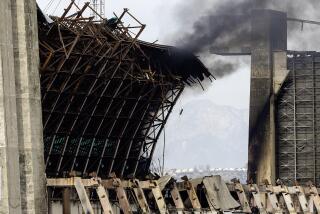Navy Wants Back Chemical Spray Systems
- Share via
The U.S. Navy is trying to recover sophisticated aerial spray systems, capable of use in chemical and biological warfare, that were mistakenly sold to a Northern California firm at an El Toro Marine Corps Air Station surplus military equipment sale.
Aero Union Corp. of Chico purchased four of the systems for $976 in 1982. Now the firm has demanded that the Navy pay $53,800 to get them back, the Sacramento Bee reported Sunday.
In the meantime, the company is advertising overseas to sell the four systems, which, if obtained by terrorists, could have “catastrophic” implications, according to one expert.
Aero Union, which specializes in fuel and chemical tank systems used primarily in fighting fires, insists it is marketing the spray system bought from the Navy solely for civilian uses.
The firm bought four complete “Aero 14-A” spray systems and eight additional components at a 1982 sale of surplus military equipment at El Toro. Although they were sold as military surplus for under $1,000, a prospectus said the equipment originally cost the government more than $108,000, the Bee said.
Fighter-Bomber Unit
The spray system looks like an expendable fuel tank and was designed to be used by jet fighter-bombers. Inside is a compressed gas unit, a 90-gallon tank and an adjustable nozzle.
Former Aero Union consultant Arnie Adams told the Bee he recommended buying the spray systems because of their adjustable nozzles, which, if modified, could be produced and marketed to spray detergent over maritime oil spills or to apply insecticides.
Built for Warfare
Adams said the Marine Corps used the systems to spray insecticides to combat malaria-carrying mosquitoes.
But Jack McGeorge, head of the Institute for Public Safety, a military consulting agency, told the Bee that the sprayers were “built for one thing and one thing only: to apply biological and chemical weapons.”
McGeorge, quoting from a Defense Department manual, said the system was designed to spray “a wide variety of chemical and biological agents.” He said they were standard items in the Marine Corps until about 1969, when the Marines “began to get out of that (biological warfare) business.”
He predicted “catastrophic” consequences if the spray systems, designed for use on aircraft, were obtained by terrorists.
Informed of Mistake
A few months after the sale, the Navy told Aero Union that the 14-As had been placed on the surplus list by mistake, according to company marketing specialist Craig Weeks.
“We were notified by telephone to not market the tanks and to return them to the Navy,” Adams recalled in a letter to the Navy on Oct. 24, 1984.
Aero Union said it would return the systems if it was reimbursed for labor, storage and expenses such as hotels and meals, which it said totaled $53,800. Aero Union general manager Victor Alvistur listed his own labor for five days at $2,500, according to the Bee.
William McCleary, a purchasing agent with the Navy’s Aviation Supply Office in Philadelphia, confirmed that he tried to buy back the systems but could not reach an agreement on price with Aero Union.
More to Read
Inside the business of entertainment
The Wide Shot brings you news, analysis and insights on everything from streaming wars to production — and what it all means for the future.
You may occasionally receive promotional content from the Los Angeles Times.









